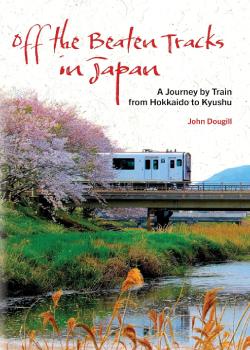Off the beaten Tracks in Japan

By John Dougill
Stone Bridge Press (2023)
ISBN-13: 978-1611720822
Review by George Mullins
In Off the beaten Tracks in Japan, John Dougill provides an excellent account of his journey by train from the Northern most point of Japan in Hokkaido to the Southern tip of Kyushu. Inspired by writers like Alan Booth who walked the entire country in the 1970s, Dougill sets out the story of his 3000-kilometre adventure across the archipelago with playfulness and intelligence in this must-read travel memoir.
As the title suggests, the author actively decided to go off the so called “beaten path” and visit some of the less well-known places in Japan. Furthermore, rather than relying on the famous shinkansen (or bullet train), he describes how he wanted to travel the country at a more leisurely pace by taking only local and express trains where possible.
If you are expecting the Japan of Tokyo, Kyoto, Osaka or Hiroshima then you might be a little disappointed. However, if you are looking to learn a bit more about Japan and dig a little deeper than the classic images of Tokyo’s Shibuya crossing or Mount Fuji, then this will certainly be the book for you.
Starting from the top of Japan in a place called Wakkanai, over the 3-month journey Dougill takes the train down through Hokkaido, under a tunnel connecting the Northern island to Honshu (Japan’s largest or main island if you will). He takes an intriguing route down Honshu following the Western coast facing the Sea of Japan. Hugging the coastline down, he travels across Honshu and over to Kyushu, another one of Japan’s largest and most populated islands. From there he weaves in and out of the island and finds himself at the Southernmost train station in Japan, Nishi-Oyama, where the story closes. Of course, Japan’s most Southern situated prefecture is Okinawa, but as Dougill himself points out they only have a mono-rail there so for the purposes of travel by train this is as far as the adventure goes.
Dougill has many interesting and funny encounters along the way, and he describes them with good humour and detail. Memorable moments include his run in with a member of the yakuza in hot-spring bath and losing his phone halfway through the trip. The local food he eats all sounds so delicious, the people he meets along the way are generous and accommodating and the scenery he describes seen from the leisurely moving local trains sounds spectacular.
Personally, the places that most intrigued me from the book are Toyama, Asahikawa and Aomori. Dougill describes Toyama as having a ‘sense of well-being and good taste’ and for Asahikawa he writes of his bewilderment at the juxtaposition of the city: ‘Exit one side, and high-rise buildings jostle for attention. Exit the other, and there was a pastoral setting’. In Aomori, Dougill visits the Sannai-Maruyama World Cultural Heritage site: an old settlement from the Jomon period now converted into a museum and reconstructed village. The Jomon were hunter-gatherer settlers in Japan existing from around 14000 to 300 BC.
From the earliest evidence of human life on the archipelago and the times of waring shogun and samurai, to the Meiji restoration, the Asia-Pacific War and to the modern Japan we know of today, Dougill’s travels and musing around the country allow us to encounter many different historical and cultural elements of the country.
A personal favourite moment in the book for me is about Dougill’s time in Matsue, and his visit to Lafcadio Hearn’s (or Koizumi Yakumo, his Japanese name) former house. The author provides a good introductory account of Hearn’s life and his admiration for the writer is clear. Perhaps Dougill’s own writing on Japan will become part of the canon of work of Western writers that Hearn is firmly situated within.
Dougill’s discussions about Japan range from religion, anthropology, history, politics, sociology, and everything in between. I found his insights into Japan to be really intriguing and nuanced. I believe that anyone interested in visiting Japan or even those people who have visited or maybe have lived in Japan will find his musing on Japan insightful.
After the end of each chapter, he provides a small but useful description of the train stations he visited such as when they were first built and what lines run there. He ends the book with a brief history of Japan’s rail system from its origins in the Meiji era (1868-1912) to the future of high-speed travel in the country. Those interested in train travel will enjoy these elements in particular.
All in all, Dougill’s account of his 3000-kilometre journey across Japan is exciting, funny, and full of insights. He draws upon his three decades of experience and vast knowledge on the history of the country to provide a memorable account of his journey. Off the beaten Tracks in Japan: A journey by Train from Hokkaido to Kyushu has certainly inspired me to follow the writers’ footsteps and travel the country from head to toe sometime! I think you too will be booking your train tickets and planning a trip across Japan after reading this one!

